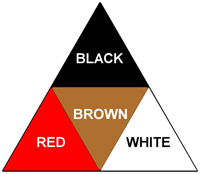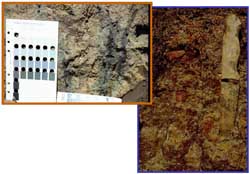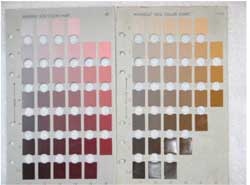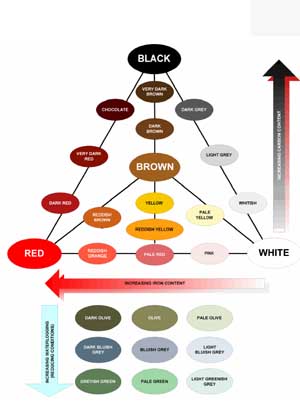Practical Note: Soil Colour
Soil Colour | Soil Particles | Bonding and Aggregation | Porosity | Changing Soil Structure | Soil Strength
Download the PDF version of this document: Practical Note: Soil Colour (PDF 738KB).
To view the information PDF requires the use of a PDF reader. This can be installed for free from the Adobe website(external link) .
Colour is one of the most obvious characteristics of soil. Colour can also provide a valuable insight into the soil environment and hence is very important in assessment and classification. The most influential colours in a well drained soil are white, red, brown and black. White indicates the predominance of silica (quartz), or the presence of salts; red indicates the accumulation of iron oxide; and brown and black indicate the level and type of organic matter. A colour triangle can be used to show the names and relationships between the four influential colours (Figure 3).
| What determines soil colour Four main factors influence the colour of a soil:
|  |
Mineral matter – rocks are broken down to form soils, and sometimes these rocks give their colour to the soil. More usually the colour of the soil results from compounds such as iron.
Organic matter – humus, the final stage of organic matter breakdown is black. Throughout the stages of organic matter breakdown the colour imparted to the soil varies from browns to black. Sodium content influences the depth of colour of organic matter and therefore the soil. Sodium causes the organic matter (humus) to disperse more readily and spread over the soil particles, making the soil look darker (blacker).
Iron – Red, yellow, grey and bluish-grey colours result from iron in various forms. Under average conditions of air and moisture, iron forms a yellow oxide imparting a yellow colour to the soil. Where soils are well draining or under dry conditions, iron forms red oxides imparting a red colour to the soil. Yet in waterlogged soil, with a lack of air, iron forms in a reduced state giving the soil grey/green/bluish-grey colours.
| Water – Soil colour darkens as the soil changes from dry to moist. But longer term colour changes are linked to water relations as well. Careful observation of colour can help to identify problems of waterlogging or leaching. Poorly drained soils are often dominated by blue grey colours often with yellow mottling. Well drained soils will usually have bright and uniform colours. Measuring soil colour Soil colour should be determined on moist surfaces of freshly broken (not sliced) soil samples. Like other soil properties, colour must always be observed throughout the whole profile, and characteristics such as mottle size, percentage and contrast should be recorded. A Munsell Soil Color Chart (Figure 2) should be used wherever possible. If a Munsell colour chart is not available to you, simple colour names as shown in Figure 3 should be used. The Munsell system divides colour into: hue; value; and chroma. Hue is the wavelength of the colour, value is the tone (from dark to light), and chroma is the colour saturation. |  Figure 1. Photograph of mottled soil, indicative of waterlogged conditions |
 Figure 2. Two pages from the Munsell Soil Colour Chart Reference: Better Soils, Agricultural Bureau of South Australia |  Figure 3. Colour triangle showing relationship between soil colours and influencing factors/conditions |


